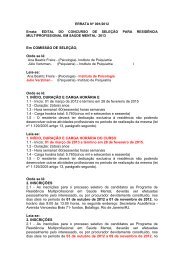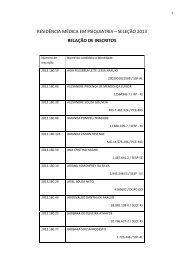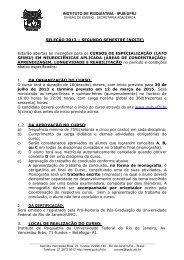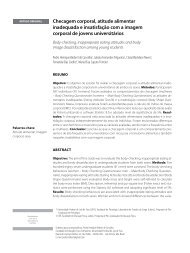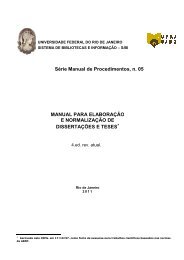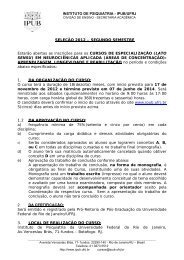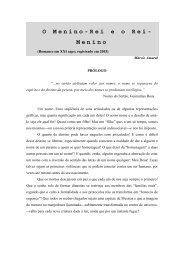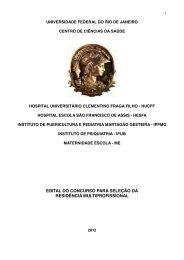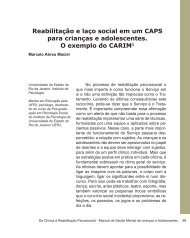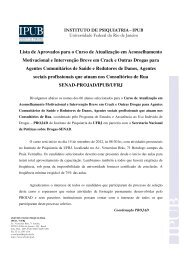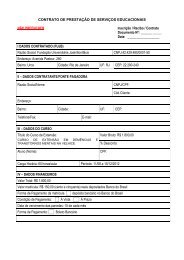Originais â Originals outubro | dezembro ⢠2011 - IPUB - UFRJ
Originais â Originals outubro | dezembro ⢠2011 - IPUB - UFRJ
Originais â Originals outubro | dezembro ⢠2011 - IPUB - UFRJ
You also want an ePaper? Increase the reach of your titles
YUMPU automatically turns print PDFs into web optimized ePapers that Google loves.
242 Benko CR et al.<br />
ORIGINAL ARTICLE<br />
such as anorexia, bulimia, and obesity. For example, the<br />
“Eating Attitude Test (EAT)” 11 is an instrument that reveals<br />
susceptibility toward the development of anorexia and<br />
bulimia nervosa in adults, whereas the “Children’s Eating<br />
Attitude Test (ChEAT)” 12 evaluates symptoms of bulimia<br />
and a preoccupation with body weight in children and<br />
adolescents.<br />
The first aim of the present work was to translate<br />
to Portuguese, adapt, and to test the reliability for the<br />
Brazilian population an instrument that is comparable to<br />
the English-language NBI in terms of being capable of<br />
flagging indicators of dietary behaviors or habits that may<br />
be related to mental disorders in people in late childhood<br />
and the start of adolescence. The second aim was to test the<br />
hypothesis that the NBI would be sufficiently sensitive to<br />
reveal associations between eating habit related risk factors<br />
and behavior in a group of children with psychopathologies<br />
relative to a healthy control group using the Child Behavior<br />
Checklist (CBCL) 13 . The CBCL is a broad spectrum inventory<br />
that documents behavioral and emotional problems and<br />
competencies in children 6 to 18 years of age 13 . The CBCL<br />
has been translated into over 80 languages and research has<br />
shown that it has great reliability and validity in clinical and<br />
non-clinical populations 14-19 . Furthermore, studies have also<br />
shown that the CBCL has good convergence with structured,<br />
interview-derived diagnostic categories 20 .<br />
The long-term objective of this work is to provide a<br />
means for performing triage (that can be used not only in<br />
Brazil, but also in English speaking countries) for mental<br />
and/or behavioral problems during the critical period of<br />
development that occurs in late childhood and adolescence,<br />
thereby facilitating the administration of further preventative<br />
actions during this stage.<br />
Method<br />
Participants<br />
This research was carried out in accordance with the<br />
Guidelines established by the Brazilian Ministry of Health’s<br />
National Commission for Research Ethics, Resolution 196/96,<br />
and was approved by the Research Committee for Human<br />
Subjects. The present investigation was part of an ongoing<br />
longitudinal clinical assessment of behavioral, mood, and<br />
learning disorders conducted in our research institute. The<br />
assessment and diagnostic methods employed are described<br />
in detailed elsewhere 21,22 . The study included only children/<br />
adolescents between 9 and 12 years of age, of both sexes,<br />
who were students in schools belonging to the Municipal<br />
Education system of Curitiba, a southern city in Brazil, and<br />
who were sent for evaluation by a multi-professional team<br />
during the period between March 2007 and November<br />
2009. To be included, the participants were required to have<br />
an intelligence quotient (IQ) ≥ 70 as determined by the third<br />
version of the Wechsler Intelligence Test (WISC-III) 23 .<br />
Parents or guardians accompanying enrolled children<br />
provided written informed consent. Since the NBI only<br />
gives indicators of eating habit behavior associated with<br />
psychological problems, we tested the applicability of the<br />
NBI by comparing the results with results obtained from the<br />
CBCL, a well established (worldwide) inventory for evaluating<br />
psychopathology in children and adolescents 14 .<br />
Study procedures<br />
The experimental strategy basically consisted of two steps:<br />
(1) “Translation, back-translation, and adaptation of the NBI”<br />
and (2) “Applicability of the NBI” utilizing results from the<br />
“Child Behavior Checklist” (CBCL).<br />
First step: translation, back-translation, and<br />
adaptation of the NBI<br />
For the translation, adaptation, and validation of the<br />
NBI for the Brazilian population, the researchers sought<br />
the authorization of the original instrument’s author in<br />
accordance with previously suggested guidelines 24-26 .<br />
Briefly, the original NBI was first translated to Portuguese by<br />
two independent professionals fluent in both the original<br />
and target languages; both versions were analyzed and<br />
synthesized. Subsequently, the synthesized version was<br />
back-translated to its original language and reviewed by an<br />
expert committee comprised of two clinical psychologists, a<br />
pediatric neurologist with an MD and a neuroscientist with a<br />
PhD. The Portuguese version of the NBI was then pretested<br />
on 20 respondents to probe for their understanding and<br />
acceptability of the test as well as for the emotional impact<br />
that the test makes. Small changes were necessary in order to<br />
adapt it to Brazilian culture. However, we avoided changing<br />
the essence of the questions as posed by the original author.<br />
Participants who were able to read fluently responded<br />
the questionnaire by self-reporting. The evaluator – a<br />
psychology professional trained and directed to maintain<br />
neutrality while reading the instrument’s questions – read<br />
the questions aloud for those who were not yet able to read<br />
fluently and helped them fill out the form in accordance with<br />
their answers.<br />
In order to verify the internal consistency of the<br />
instrument’s items, Cronbach’s alpha was used. A construct<br />
can be indirectly validated with an internal base of consistency<br />
or no relation between the questions that make up part of<br />
the scale, indirectly leading to the conclusion that the scale is<br />
a valid construction 27 . The Cronbach’s alpha coefficient is the<br />
simplest and best-known measure of internal consistency<br />
and is the primary approach used in constructing the<br />
validation of a scale. In general, a group of items that explore<br />
a common factor have a high Cronbach’s alpha value.<br />
J Bras Psiquiatr. <strong>2011</strong>;60(4):240-6.




